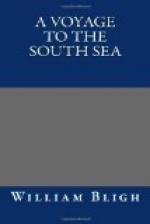On the 13th of June the Dublin East Indiaman arrived from England, on board of which ship was a party of the 77th regiment under the command of colonel Balfour.
The result of my lunar observations gave for the longitude of Simon’s Bay 18 degrees 48 minutes 34 seconds east; the latitude 34 degrees 11 minutes 34 seconds south. The timekeeper likewise made the longitude 18 degrees 47 minutes east. The longitude as established by former observations is 18 degrees 33 minutes east. The variation of the compass on shore was 24 degrees 4 minutes west; but on board of the ship it was only 22 degrees 28 minutes west. The time of high-water was three-quarters past two on the full and change and it then flowed six feet.
With respect to the Cape Promontory it lies about three miles east of the meridian of Simon’s Town. All the tables of latitude and longitude place the Cape in 34 degrees 29 minutes south latitude; but from many observations off it with good instruments I make it to lie in 34 degrees 23 minutes south, which agrees with its situation as laid down in major Rennel’s map. The part which I call the Cape is the southernmost point of the land between Table Bay and False Bay; but the Dutch consider the westernmost part of the coast to be the Cape.
Sunday 29.
On the 29th, being ready for sea, I took the timekeeper and instruments on board. The error of the timekeeper was 3 33 seconds, 2 too slow for the mean time at Greenwich, and its rate of going 3 seconds per day, losing. The thermometer during our stay here was from 51 to 66 degrees.
July. Tuesday 1.
We had been thirty-eight days at this place, and my people had received all the advantage that could be derived from the refreshments of every kind that are here to be met with. We sailed at four o’clock this afternoon, and saluted the platform with thirteen guns as we ran out of the bay, which were returned.
CHAPTER 4.
Passage towards Van Diemen’s Land. Make the Island of St. Paul. Arrival in Adventure Bay. Natives seen. Sail from Van Diemen’s Land.
1788. July.
We lost sight of the land the day after leaving False Bay and steered towards the east-south-east, having variable winds the first week with much thunder, lightning and rain. The remainder of this passage the winds were mostly between the south and west blowing strong. There were almost every day great numbers of pintada, albatrosses, blue petrels, and other oceanic birds about us; but it was observed that if the wind came from the northward, only for a few hours, the birds generally left us, and their presence again was the forerunner of a southerly wind.
Sunday 13.
The variation of the compass was 30 degrees 34 minutes west which was the greatest variation we found in this track. Our latitude 36 degrees 28 minutes south and longitude 39 degrees 0 minutes east.




